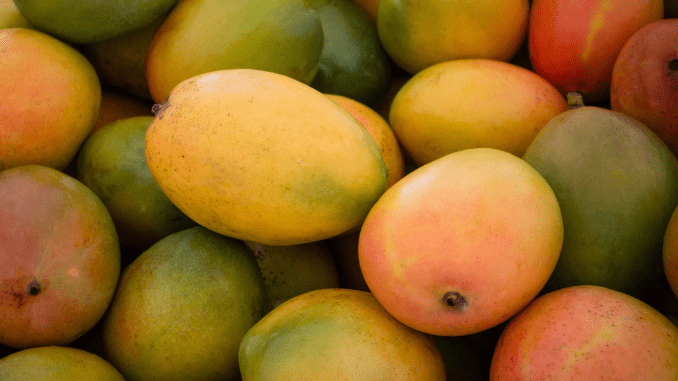Introduction
Mango ( Magnifera indica ) is a tropical, stone (large seed in the middle) fruit native to India, Southeast Asia, Africa, and Central America have been cultivated for nearly 4000 years. Many varieties of mangoes are available according to their rich aroma, taste, shape, and size. This article is all about the best Mangoes in season and their special characters.
Mango – “ The king of fruits” Elixir of life which is incomparable in taste & smell
 Mangoes are very famous all over the world and are loved by everyone because of their juicy unique taste of pulp and luscious, sweet rich aroma. Not only that, some polyphenol which is found in mango is very good overall specifically in digestive health and it has an impressive nutritional profile. Low in calories and packed with nutrients. Most versatile fruits are easily added to various kinds of foods. Mangoes can be eaten both raw and ripe but ripe mangoes are mainly available from May to September. Very good mangoes are available mainly from May to September (1).
Mangoes are very famous all over the world and are loved by everyone because of their juicy unique taste of pulp and luscious, sweet rich aroma. Not only that, some polyphenol which is found in mango is very good overall specifically in digestive health and it has an impressive nutritional profile. Low in calories and packed with nutrients. Most versatile fruits are easily added to various kinds of foods. Mangoes can be eaten both raw and ripe but ripe mangoes are mainly available from May to September. Very good mangoes are available mainly from May to September (1).
India is the largest mango producer (approx an estimated 24.7 million tons annually) in the world. Many varieties of mangoes are available in season but among them, Alphonso is the most famous (2).
List of different varieties of Mangoes in season
There are many types of mango, each with its own characteristics and cooking methods. One of the most popular names is Alphonso mango from India, specifically the Konkan region.
Alphonso
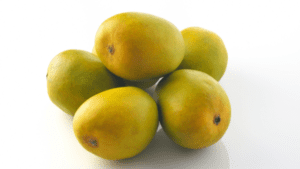
These mangoes are known for their sweet scent, low fiber, good nutrition, and juicy flesh. Ripe fruits are golden rind and reddish-crowned and are usually harvested from April to June. They are often used to make smoothies, ice cream, and milkshakes.
Langra mango
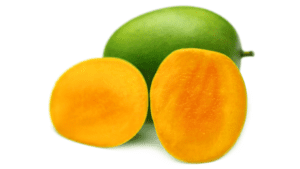
Another type of mango is Langra, which is mainly grown in the West Bengal, Marda, and Murshidabad regions of India and Benaras in Uttar Pradesh. Langra mangoes are generally yellow-green in color, with sweet and aromatic flesh, fiber-free, juicy, and rich in sweet and sour taste. They are usually harvested from mid-June to July and are often used to make lassi, desserts, baked goods, and fruit salads.
Miyazaki mango
Miyazaki mangoes in Japan are also considered “daily eggs”. It has a beautiful golden color and is considered the most expensive mango due to its special conditions and soil.
Sharp, sweet, and high in sugar, Miyazaki mangoes are usually harvested from April to August. They are used in many dishes such as desserts, fresh fruit salads, custard, pastas, and curries.
Chausa mango
Often called the “King of Mangoes,” Chausa mangoes are grown mainly in India and Pakistan. They have a golden-yellow crust and a pleasant, sweet flesh with a sweet and spicy aroma. Chausa mangoes are rich in vitamin C and are usually harvested from late June to August. They are often used in mango pickles, raw mango pickles, lassi, and ripe mango desserts.
Himasagar mango
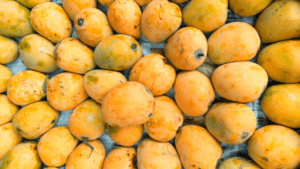
Himsagar Mango is produced in West Bengal, India, and Bangladesh and has a yellow-green color when ripe. They are harvested from late May to July and are known for their uniquely sweet, juicy, and fibrous pulp. Himsagar mango is used in many dishes, including raw and cooked mangoes, desserts, custards, and desserts.
Anwar Ratol
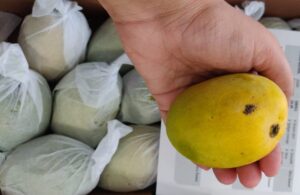
Anwar Ratol Mango, native of Ratoor village, Uttar Pradesh, India, is small, yellow-skinned, and pleasantly flavored.
There are two varieties, which are harvested in May and June, non-sweet, fiberless, and thick-shelled. They are often used in desserts.
Kensington Pride
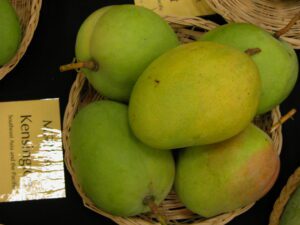
Kensington Pride Mango, from northern Queensland, Australia, oval-shaped, medium fiber, yellow flesh. They have a balanced flavor and are usually harvested from September to February. These mangoes are often used in dishes such as children’s desserts, curries, ice creams, and milkshakes.
Kate
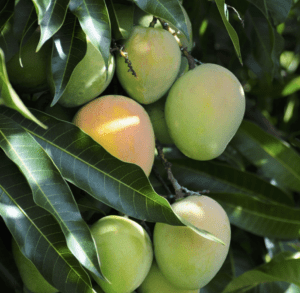
Kate mango is produced in Florida, USA, and has a large, semi-fibrous flesh and a strong flavor. The bark is green with a reddish tinge and is usually harvested in August-September. Kate Mango can be used in many recipes such as barbecue sauces, smoothies, fruit salads, and jams.
Tommy Atkins
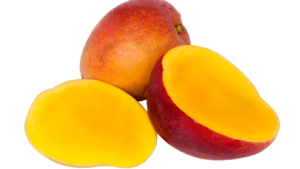
Tommy Atkins mango, also from Florida, USA, is sweet, oval in shape, grayish-red peel, and contains a lot of fiber. They are harvested from May to August and can be consumed fresh or added to fruit salads, dressings, and dressings.
Urban variations of the Tommy Atkins mangoes are oval in shape with a green peel and a reddish top. Their flesh is tender and juicy, fibrous, and has a rich flavor
Kent mangoes
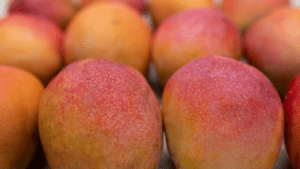
Kent mangoes are usually harvested from July to September and are commonly used in many desserts and fresh fruits. These plants, which used to be grown in Florida, are now grown in Mexico, Ecuador, and Peru.
Ataulfo Mangoes
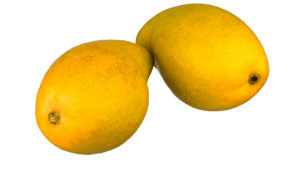
Ataulfo mango, skin yellow, red, oblong, fiberless, sweet flesh.
They are mostly grown in Mexico and are used in dishes such as milkshakes, smoothies, and sorbets.
Francis mangoes
Francis mangoes from Haiti and Ecuador are sweet, stringy, tropical aromatic, and have soft, juicy flesh. The skin color varies from bright yellow to golden with a green blush on top. They are oval in shape and are harvested between May and June. Francis mangoes are often used in fresh salads and desserts.
Harden mangoes
Harden mangoes from Mexico, Peru, and Ecuador are medium fiber, sweet and sour. The skin is yellow-green with a red blush dotted with white dots. Hardene mangoes are oval to round in shape and are usually harvested from May to September. They are often used in desserts, smoothies, and fruit salads.
Characterization for selection of the best mangoes
Visual Selection
1. Well-ripened ring
The rind of well-ripened sweet mangoes is dark green, yellowish orange, and yellowish red. In some best mangoes, the peel is also thin, smooth, and flawless.
2. Texture
The texture is smooth in well-ripened mangoes.
3. Softness
A well-ripe mango is neither too hard nor too soft.
4. Pulp color
The pulp of a well-ripe mango is yellow in color and very smooth
Other criteria
1. Smell
The smell of good ripe mango is very strong and good. The aroma of good mangoes is a sweet, rich, and distinct fragrance.
2. Ripeness indicator
- In the case of good tree-ripened (chemical-free) mangoes, the outer side of the flesh is a little hard and the inner side is a little soft.
- Ripening of the mango starts from the stem side of the tree for which the initial color is yellow and the rest is dark green.
- A Good ripe mango is characterized by a slight squeeze when touched with the fingers. But if the mango is not ripe it will be hard.
Recipes
Oats mango kheer ( sweet dessert) – Tasty, healthy nutritious dessert recipe
serving size -3 to 4
Cook time – 15 min
Ingredients:
- Overnight soaked Rolled oats or steel-cut Oats ( both of them are the most healthy version of oats) – 1 cup
- Milk- (preferred double-toned milk)- 500ml
- Organic jaggery powder from sugarcane or organic honey- As per taste
- Dry fruits – As desired
- Mango pulp – ½ cup
- Condensed milk- 2-3 tablespoons. Khoya kheer (Bengali delicacy)- optional
- Freshly cut sliced mango with pistachio
Instructions:
1. First, the milk should be boiled and thickened with jaggery powder.
2. After that add the oats to the milk and boil it
3. After some time add the mango pulp and stir well.
4. Then add the condensed milk little by little. Add Khoya Kheer if you wish
5. Then cool and refrigerate for a few hours.
6. Add dry fruits and pistachio with freshly cut mango cubes on chilled delicious kheer.
Q&A
1. What is the best-tasting mango?
Langra, Chausa, etc.
2. Which is the no 1 Mango in the world?
Alphonso is the best in the world.
3. What is the top sweetest mango in the world?
Carabao mango is the sweetest in the world.
Summary
1. Mango is a climacteric, nutritionally complete fruit that is found in abundance all over the world. It also has great economic value worldwide.
2. Carbohydrates, proteins, fats, micronutrients like vitamins A, C, D, E, and K, and different kinds of pigments are found in mangoes.
3. The presence of antioxidants in mangoes reduces cardiovascular disease and inflammatory processes. This also activates the signaling pathways of gene expression.
4. It has many dietary fibers which have good effects on digestive and cardiovascular diseases.
5. It has lots of minerals like calcium, copper sodium, magnesium, zinc, and iron which have very good effects on overall health.
6. The above article is all about the different varieties of mangoes in season and their special characteristics.
7. Some of the major varieties of mangoes are Alphanso, Chausa, Kate, etc.
